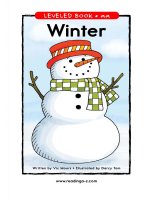raz lu26 meteorsandmeteorites
Bạn đang xem bản rút gọn của tài liệu. Xem và tải ngay bản đầy đủ của tài liệu tại đây (2.4 MB, 26 trang )
Meteors and
Meteorites
LEVELED BOOK • U
A Reading A–Z Level U Leveled Book
Word Count: 1,633
Meteors
and
Meteorites
Written by John Perritano
Visit www.readinga-z.com
for thousands of books and materials.
www.readinga-z.com
Meteors
and
Meteorites
Written by John Perritano
www.readinga-z.com
The Hoba Meteorite in Namibia (Africa) is the largest known meteorite that
is still in one piece.
Table of Contents
The Sky Is Falling...................................................... 4
Comets, Asteroids, and Meteoroids....................... 6
A Martian Has Landed............................................. 8
Mighty Meteors......................................................... 9
Fireballs and Micrometeorites............................... 11
Meteor Showers....................................................... 13
Space Gold............................................................... 15
Types of Meteorites................................................. 17
Dying Dinos............................................................. 19
Target Earth?............................................................ 21
Glossary.................................................................... 23
Index......................................................................... 24
Meteors and Meteorites • Level U
3
Meteorites found
Reno
Sacramento
Nevada
California
Arizona
PACIFIC
OCEAN
The Hoba Meteorite in Namibia (Africa) is the largest known meteorite that
is still in one piece.
MEXICO
Table of Contents
The Sky Is Falling...................................................... 4
Comets, Asteroids, and Meteoroids....................... 6
A Martian Has Landed............................................. 8
Mighty Meteors......................................................... 9
Fireballs and Micrometeorites............................... 11
Meteor Showers....................................................... 13
Space Gold............................................................... 15
Types of Meteorites................................................. 17
Dying Dinos............................................................. 19
Target Earth?............................................................ 21
Glossary.................................................................... 23
Index......................................................................... 24
Meteors and Meteorites • Level U
3
A meteor passes over Reno, Nevada, on the morning of April 22, 2012.
The Sky Is Falling
The morning of April 22, 2012, began quietly.
Suddenly, a ball of fire streaked through the sky
over Nevada and California. Hundreds of people
on the ground reported seeing the object passing
high overhead. Many also heard a loud boom
and said that their windows shook. The fastmoving ball of fire shone brightly as it raced
through the sunny morning sky. Moments later,
the object exploded in the air northeast of
Sacramento, California, scattering pieces of itself
over a wide area.
4
The flying object that lit up the sky that
morning was a hunk of rock from space—a
meteor. The meteor broke into pieces over an area
of California where the famous gold rush of 1849
began. The minivan-sized meteor’s explosion set
off a second gold rush of sorts as thousands of
treasure seekers flocked to the area to look for
meteorites, or pieces of the meteor, worth more
than their weight in gold. Many scientists also
rushed to the scene, hoping to recover meteorites
that might help them learn more about the origins
of our solar system.
Their efforts soon paid off as scientists
and amateurs alike quickly found pieces of the
meteor. Tests revealed that the rocks came from a
rare kind of meteor that might be 4.5 billion years
old—as old as our solar system.
Robert Ward shows two pieces of the California meteor that he found.
Meteors and Meteorites • Level U
5
The flying object that lit up the sky that
morning was a hunk of rock from space—a
meteor. The meteor broke into pieces over an area
of California where the famous gold rush of 1849
began. The minivan-sized meteor’s explosion set
off a second gold rush of sorts as thousands of
treasure seekers flocked to the area to look for
meteorites, or pieces of the meteor, worth more
than their weight in gold. Many scientists also
rushed to the scene, hoping to recover meteorites
that might help them learn more about the origins
of our solar system.
Their efforts soon paid off as scientists
and amateurs alike quickly found pieces of the
meteor. Tests revealed that the rocks came from a
rare kind of meteor that might be 4.5 billion years
old—as old as our solar system.
Where did the California meteor come from?
Outer space is full of objects left over from
the time when the planets in our solar system
formed. Comets, asteroids, and meteoroids are
three different kinds of these “leftovers.”
Comets are dirty snowballs. They are huge
lumps of dirt and rock mixed in with frozen
water and gases. Most comets travel through the
Kuiper (KY-per) Belt, an area of our solar system
located beyond the planets.
Asteroids are rocks that range from about the
size of a school bus to as large as a small moon.
Asteroids mainly orbit the Sun in the asteroid
belt, which is between Mars and Jupiter.
Most of the space rocks that make their way to Earth come from the
Asteroid Belt or the Kuiper Belt. Many comets have large orbits that carry
them far beyond the planets. (Drawing not to scale.)
Robert Ward shows two pieces of the California meteor that he found.
Meteors and Meteorites • Level U
Comets, Asteroids, and Meteoroids
5
6
An artist’s drawing shows an asteroid being broken apart by the gravity
of a nearby star.
Meteoroids are rocks much smaller than
comets and asteroids. Some are no bigger than a
speck of sand. Others are as large as boulders. A
meteoroid becomes a meteor when it hits Earth’s
atmosphere. We see meteors as streaks of light
racing through the sky—”shooting stars.” When
a meteor hits Earth’s surface, scientists call it
a meteorite.
Meteorites are unlike any rocks on Earth. As
our solar system originally took shape, bits of
asteroids and planets broke apart. The rocks flew
through outer space as meteoroids. Some are still
crashing into Earth as meteorites. By studying
these space rocks, scientists can figure out how
our solar system formed. They can also learn how
meteorites have changed our planet.
Meteors and Meteorites • Level U
7
A Martian Has Landed
In 1984, meteorite hunters found a greenish
rock in Antarctica. Scientists were shocked when
they studied the stone. This was no ordinary
meteorite. Tests showed that the rock, about the
size of a potato, came from Mars.
An artist’s drawing shows an asteroid being broken apart by the gravity
of a nearby star.
Meteoroids are rocks much smaller than
comets and asteroids. Some are no bigger than a
speck of sand. Others are as large as boulders. A
meteoroid becomes a meteor when it hits Earth’s
atmosphere. We see meteors as streaks of light
racing through the sky—”shooting stars.” When
a meteor hits Earth’s surface, scientists call it
a meteorite.
Meteorites are unlike any rocks on Earth. As
our solar system originally took shape, bits of
asteroids and planets broke apart. The rocks flew
through outer space as meteoroids. Some are still
crashing into Earth as meteorites. By studying
these space rocks, scientists can figure out how
our solar system formed. They can also learn how
meteorites have changed our planet.
Meteors and Meteorites • Level U
7
How did a Martian rock land on Earth
some 140 million miles (225 million km) away?
Scientists believe an asteroid or comet slammed
into Mars 15 million years ago. The crash tossed
the rock toward Earth, where it arrived only
13 thousand years ago.
Scientists collect a meteorite from the ice in Antarctica.
8
Scientists estimate that there are 300,000 large impact craters on the side
of the Moon that faces Earth. Many more are on the Moon’s far side.
Mighty Meteors
When people say they’ve seen a shooting
star, what they really saw was a blazing meteor
streaking through Earth’s atmosphere. The
ancient Greeks believed the flashes of light were
weapons of the gods. What they didn’t know is
that most meteoroids are pieces that have broken
away from asteroids. Meteors are chunks of
comets and planets.
Meteorites can do a lot of damage. Just gaze
up at the Moon to see the evidence. The many
circular craters on the Moon’s surface are the
result of millions of strikes by meteors and comets.
Meteors and Meteorites • Level U
9
Since there is no atmosphere on the Moon,
there’s nothing to protect its surface from
these flying space rocks. Luckily, Earth has an
atmosphere that shields our planet. When a
meteor collides with Earth’s atmosphere, the
fast-moving rock pushes air out of its way. As air
particles move past the surface of a meteor at
high speed, they cause the meteor to heat up and
break into pieces. As those pieces burn up, the
meteor glows in brilliant, fiery streaks of light.
Then it vanishes as quickly as it appeared.
1
A fast-moving meteor enters
Scientists estimate that there are 300,000 large impact craters on the side
of the Moon that faces Earth. Many more are on the Moon’s far side.
2
It rubs against the air, causing it
Mighty Meteors
to heat up and glow.
When people say they’ve seen a shooting
star, what they really saw was a blazing meteor
streaking through Earth’s atmosphere. The
ancient Greeks believed the flashes of light were
weapons of the gods. What they didn’t know is
that most meteoroids are pieces that have broken
away from asteroids. Meteors are chunks of
comets and planets.
3
The meteor leaves behind a trail
of melting rock and hot gases.
4
Most meteors break apart and burn up
in the air before reaching the ground.
3
4
Meteorites can do a lot of damage. Just gaze
up at the Moon to see the evidence. The many
circular craters on the Moon’s surface are the
result of millions of strikes by meteors and comets.
Meteors and Meteorites • Level U
1
the atmosphere.
9
10
2
Fireballs and Micrometeorites
On February 2, 2012, residents of Amarillo,
Texas, heard a loud boom at around 8:00 p.m.
When people looked up, they saw a blazing
meteor light up the sky.
What people saw was a special type of
meteor that scientists call a fireball. Because some
meteoroids are huge, they grow extremely bright
when striking the atmosphere. In fact, some get
as bright as the Moon for a short time.
This fireball, seen over California’s Mojave Desert in 2009, was caused
by a meteor that was once part of a comet.
Meteors and Meteorites • Level U
11
Fireballs and Micrometeorites
On February 2, 2012, residents of Amarillo,
Texas, heard a loud boom at around 8:00 p.m.
When people looked up, they saw a blazing
meteor light up the sky.
What people saw was a special type of
meteor that scientists call a fireball. Because some
meteoroids are huge, they grow extremely bright
when striking the atmosphere. In fact, some get
as bright as the Moon for a short time.
A U.S. Navy fighter jet breaks the sound barrier, causing water droplets
to form clouds in the shape of shock waves.
What was the blast that everyone heard? The
fireball was moving faster than the speed of
sound, which is roughly 760 miles (1,223 km) per
hour. As the object raced through the atmosphere,
it shattered the sound barrier. Kaboom! The noise
that shook Amarillo was a sonic boom. Sonic
booms can be low, rumbling sounds or earsplitting explosions. The noise can shake the
ground and even break windows.
Fireballs are rare. Micrometeorites are not.
Most of these tiny meteors are smaller than a
freckle. Tons of micrometeorites pass through the
air and fall to Earth every year.
This fireball, seen over California’s Mojave Desert in 2009, was caused
by a meteor that was once part of a comet.
Meteors and Meteorites • Level U
11
12
Some meteor showers produce more than one meteor per minute.
Meteor Showers
What type of shower won’t get you wet? A
meteor shower, of course! Meteor showers are
brief periods of heavy meteor activity. They are
fun to watch, and you don’t need an umbrella.
Most meteor showers happen at the same
time every year. They are often named after the
constellation in which they seem to appear. For
example, every November the Leonid meteor
shower appears in the same area of the sky as
the constellation Leo. Hundreds, sometimes
thousands, of meteors can streak across the sky
every hour.
Meteors and Meteorites • Level U
13
Scientists know when meteor showers will
happen because they begin each time Earth
passes behind a comet. As the comet closes in on
the Sun, it leaves a “tail” of dust and melting ice
behind it in space. When Earth passes through the
comet’s tail, the dust burns up in the atmosphere,
creating a natural fireworks show.
Some meteor showers produce more than one meteor per minute.
Gas tail
Energy from
the Sun
Meteor Showers
What type of shower won’t get you wet? A
meteor shower, of course! Meteor showers are
brief periods of heavy meteor activity. They are
fun to watch, and you don’t need an umbrella.
Most meteor showers happen at the same
time every year. They are often named after the
constellation in which they seem to appear. For
example, every November the Leonid meteor
shower appears in the same area of the sky as
the constellation Leo. Hundreds, sometimes
thousands, of meteors can streak across the sky
every hour.
Meteors and Meteorites • Level U
Dust tail
A comet leaves behind a tail of dust and gas as it moves through space.
13
14
Space Gold
Scientists say an ancient meteor shower is the
reason gold can be found in the rocks near Earth’s
surface.
Why do they say that?
When Earth began forming around 4.5 billion
years ago, it was a big ball of molten rock.
As Earth cooled, iron sank to the center of the
planet, forming Earth’s core. Some other metals,
including gold, sank with the iron.
Crust
Mantle
Solid inner core
Liquid outer core
Scientists estimate
that 99 percent
of Earth’s gold
sank to its core
when our planet
was still forming.
Meteors and Meteorites • Level U
15
Space Gold
Scientists say an ancient meteor shower is the
reason gold can be found in the rocks near Earth’s
surface.
Why do they say that?
When Earth began forming around 4.5 billion
years ago, it was a big ball of molten rock.
As Earth cooled, iron sank to the center of the
planet, forming Earth’s core. Some other metals,
including gold, sank with the iron.
Crust
Did these gold nuggets journey to Earth from space?
Mantle
Solid inner core
Liquid outer core
Scientists estimate
that 99 percent
of Earth’s gold
sank to its core
when our planet
was still forming.
Meteors and Meteorites • Level U
15
If all the gold sank, scientists wondered, where
do we find the gold to make watches, bracelets,
and other items? About 650 million years after
Earth formed, a firestorm of meteorites rained
down. That meteor shower forever changed the
makeup of Earth’s crust. Scientists say that so
many meteorites slammed into our planet that
if you put them all together, they would weigh
about one-fourth as much as Earth’s moon. Most
of the gold we use for jewelry and coins came
from those meteorites.
16
Types of Meteorites
Meteorites can give us clues as to how our
solar system formed. Yet, not all meteorites are
the same. Meteorites come in three main types.
Nearly all meteorites are stone. Some stony
meteorites come from the Moon or Mars. A few
contain small, glassy beads, which formed under
high heat at the time the solar system began to
form.
Iron meteorites come from the core of a longvanished asteroid or planet. These meteorites
are dark and look as if they are rusting. Iron
meteorites are very heavy and sometimes have
surfaces that look the way a lump of clay looks
after being pressed all over with fingertips. Early
humans made tools and weapons out of the iron
meteorites they found.
How Common Is Each Type of Meteorite?
Stony-iron
meteorites
1%
Stony
meteorites
92%
Meteors and Meteorites • Level U
Iron
meteorites
7%
17
Types of Meteorites
Meteorites can give us clues as to how our
solar system formed. Yet, not all meteorites are
the same. Meteorites come in three main types.
Nearly all meteorites are stone. Some stony
meteorites come from the Moon or Mars. A few
contain small, glassy beads, which formed under
high heat at the time the solar system began to
form.
Iron meteorites come from the core of a longvanished asteroid or planet. These meteorites
are dark and look as if they are rusting. Iron
meteorites are very heavy and sometimes have
surfaces that look the way a lump of clay looks
after being pressed all over with fingertips. Early
humans made tools and weapons out of the iron
meteorites they found.
How Common Is Each Type of Meteorite?
Stony-iron
meteorites
1%
Stony
meteorites
92%
Meteors and Meteorites • Level U
Arizona’s Barringer Crater was created by an iron meteorite approximately
50,000 years ago.
Stony-iron are the last type of meteorites. If
you find one, you’re lucky. Stony-iron meteorites
are rare. As their name suggests, these space rocks
are a mix of stone and iron.
Meteorite impacts can be devastating. On
land, a meteorite strike can create a gigantic
explosion and powerful shock waves. Fortunately,
the most destructive meteorite impacts happened
long ago. Not only does Earth’s atmosphere
protect the planet, but the pull of the Moon’s
gravity steers some meteoroids away from us.
Iron
meteorites
7%
17
18
Dying Dinos
Scientists say, however, that some 65 million
years ago, one very large meteorite got through.
At the time, Earth was home to many kinds of
dinosaurs.
After the large meteorite struck Earth,
the dinosaurs vanished. Earth turned into a
wasteland. Although scientists aren’t completely
sure, they believe a massive meteorite or asteroid
strike blasted the dinosaurs into extinction.
Scientists say the impact threw huge amounts of
dust, gas, and rock into the air. The blast changed
Earth’s climate, killing almost everything.
The meteorite that most likely caused the extinction of the dinosaurs is
thought to have been about 12.4 miles (20 km) wide. That’s about 1,770
times the length of a school bus.
Meteors and Meteorites • Level U
19
Dying Dinos
United States
Scientists say, however, that some 65 million
years ago, one very large meteorite got through.
At the time, Earth was home to many kinds of
dinosaurs.
Giant meteorite
crater
atá
n
Mexico
Yu
c
After the large meteorite struck Earth,
the dinosaurs vanished. Earth turned into a
wasteland. Although scientists aren’t completely
sure, they believe a massive meteorite or asteroid
strike blasted the dinosaurs into extinction.
Scientists say the impact threw huge amounts of
dust, gas, and rock into the air. The blast changed
Earth’s climate, killing almost everything.
G U L F O F M E X IC O
Scientists have found a giant meteorite crater on the edge of the Yucatán
(yoo-cuh-TAN) Peninsula in Mexico. It may be connected to the extinction
of the dinosaurs.
Why do scientists say a meteorite was the
cause? One possible answer comes from scientists
who study layers of rock on Earth’s surface.
They noticed that at the same time the dinosaurs
disappeared, the amount of iridium (ih-RIH-deeum) on the planet went up dramatically. Iridium
is a metal that is rare on Earth but is common
elsewhere in our solar system. The sudden increase
of iridium in Earth’s rock layers made scientists
suspect that a large meteorite slammed into Earth,
bringing a huge amount of iridium with it.
The meteorite that most likely caused the extinction of the dinosaurs is
thought to have been about 12.4 miles (20 km) wide. That’s about 1,770
times the length of a school bus.
Meteors and Meteorites • Level U
19
20
This computer-generated image shows how Planetary Resources plans
to use a spacecraft to capture an asteroid for mining.
Asteroid Mining
While some people see giant rocks in space as a threat,
others see them as an opportunity. A company called
Planetary Resources wants to send spacecraft to mine
asteroids in space. According to the company, more than
1,500 asteroids orbit near Earth and could be easily reached
using today’s technology. Asteroids contain many valuable
resources including precious metals and rare minerals.
Asteroids may also contain a resource that’s particularly
valuable in space—water.
Target Earth?
The chances of another giant meteorite coming
our way are slim. In 1908, a meteorite blew apart
over the Tunguska River in Siberia. The blast
leveled 400 square miles (1,000 sq km) of forest.
Had the meteorite struck a city, the destruction
would have been massive. However, we
shouldn’t worry too much. Scientists say chances
are that a large meteorite will hit a major city only
about once every 10,000 years.
Meteors and Meteorites • Level U
21
This computer-generated image shows how Planetary Resources plans
to use a spacecraft to capture an asteroid for mining.
Asteroid Mining
While some people see giant rocks in space as a threat,
others see them as an opportunity. A company called
Planetary Resources wants to send spacecraft to mine
asteroids in space. According to the company, more than
1,500 asteroids orbit near Earth and could be easily reached
using today’s technology. Asteroids contain many valuable
resources including precious metals and rare minerals.
Asteroids may also contain a resource that’s particularly
valuable in space—water.
Target Earth?
The chances of another giant meteorite coming
our way are slim. In 1908, a meteorite blew apart
over the Tunguska River in Siberia. The blast
leveled 400 square miles (1,000 sq km) of forest.
Had the meteorite struck a city, the destruction
would have been massive. However, we
shouldn’t worry too much. Scientists say chances
are that a large meteorite will hit a major city only
about once every 10,000 years.
Meteors and Meteorites • Level U
21
Yet, meteorites continue to fall and always
will. If you look up in the sky tonight, you might
see a meteor streak across the horizon as it ends
its journey through space and time in a blazing
show of light.
22
Glossary
atmosphere (n.)
a layer of gases surrounding
a planet, star, or moon (p. 7)
collides (v.)
impacts something violently
or forcefully (p. 10)
comets (n.)
space objects made of ice and
dust that develop long, bright
tails as they near the star they
orbit (p. 6)
constellation (n.) a group of stars that form a
shape and are named (p. 13)
craters (n.)
holes in the ground caused by
explosions or impacts (p. 9)
gravity (n.)
the natural force that tends to
pull objects toward each other,
such as objects pulled toward
the center of Earth (p. 18)
meteor (n.)
a meteoroid that burns up after
entering Earth’s atmosphere,
causing a bright streak of light
in the sky (p. 5)
meteorites (n.)
a meteoroid that has landed on
Earth from outer space (p. 5)
meteoroids (n.)
comets, asteroids, or dust
particles in space (p. 6)
Meteors and Meteorites • Level U
23
Glossary
orbit (v.)
a layer of gases surrounding
a planet, star, or moon (p. 7)
to revolve around another
object (p. 6)
particles (n.)
tiny pieces of matter (p. 10)
collides (v.)
impacts something violently
or forcefully (p. 10)
solar system (n.) a group of objects in space that
orbit a star (p. 5)
comets (n.)
space objects made of ice and
dust that develop long, bright
tails as they near the star they
orbit (p. 6)
atmosphere (n.)
constellation (n.) a group of stars that form a
shape and are named (p. 13)
craters (n.)
holes in the ground caused by
explosions or impacts (p. 9)
gravity (n.)
the natural force that tends to
pull objects toward each other,
such as objects pulled toward
the center of Earth (p. 18)
meteor (n.)
a meteoroid that burns up after
entering Earth’s atmosphere,
causing a bright streak of light
in the sky (p. 5)
meteorites (n.)
a meteoroid that has landed on
Earth from outer space (p. 5)
meteoroids (n.)
comets, asteroids, or dust
particles in space (p. 6)
Meteors and Meteorites • Level U
23
Index
Antarctica, 8
asteroid(s), 6–9, 17, 19, 21
mining, 21
Asteroid Belt, 6
atmosphere, 7, 9–12, 14,
18
California meteor, 4–6
comet(s), 6–9, 11, 14
constellation, 13
crater(s),
Barringer, 18
Hoba meteorite, 2
Moon, 9
Yucatán, 20
dinosaur extinction, 19,
20
fireball(s), 11, 12
gold, 15, 16
gravity, 7, 18
iridium, 20
Kuiper Belt, 6
Mars, 6, 8, 17
24
meteor(s), 2, 4–7,
9–13, 22
meteor shower(s), 2,
13–16
Leonid, 13
meteorite(s), 2, 3, 5–9,
16–22
iron, 17
stony, 17
stony-iron, 17, 18
meteoroid(s), 6, 7, 9,
11, 18
micrometeorite(s), 11,
12
Moon, 9–11, 16–18
shooting star(s), 7, 9
solar system, 5–7, 17, 20
sonic boom, 12
sound barrier, 12
Tunguska River, 21
Yucatán, 20
Meteors and
Meteorites
LEVELED BOOK • U
A Reading A–Z Level U Leveled Book
Word Count: 1,633
Meteors
and
Meteorites
Written by John Perritano
Visit www.readinga-z.com
for thousands of books and materials.
www.readinga-z.com









